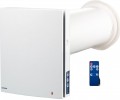Minimum air flow (ventilation)
The lowest performance with which the supply-exhaust unit can operate.
For performance in general, see "Maximum air flow". Here we note that it makes sense to indicate the minimum flow only in cases where the amount of air passed can be regulated (see "Number of fan speeds"). And even then, for such models, this parameter is not always given.
Maximum air flow (ventilation)
The highest performance of the air ventilation unit; or, if the air flow control is not provided for in the design, the nominal capacity of the unit.
In this case, air flow refers to the amount of air that the unit can pass through itself per hour. The optimal air flow value for each room is calculated by the formula "room volume multiplied by the air exchange rate"; the air flow must not be lower than this indicator; otherwise, we cannot talk about effective ventilation. The volume is easy to calculate by multiplying the area of the room by the height of the ceilings, and the multiplicity indicates how many times per hour the air in the ventilated space should be updated. It depends on the type and purpose of the room: for example, a multiplicity of 1 is enough for a residential apartment, and at least 4 is required for a pool (there are special tables by which you can determine the multiplicity for each type of room). Thus, for example, for an apartment with a living area of 70 m², a ceiling height of 2.5 m and a kitchen of 9 m² (air exchange rate of at least 2), a duct of at least 70*2.5*1+9*2.5*2=220 m³ (excluding bathroom and toilet, they have their requirements for multiplicity).
It should be noted that a certain flow margin (about 10–15%) will not be superfluous, but it hardly makes sense to chase higher rates — after all, performance requires appropriate power, which, in turn, affects the dimensions, price and
...energy consumption of the installation. Control via Internet
Ability
to control device via the Internet. The connection of the unit to the World Wide Web, usually, is carried out via Wi-Fi, and the control format may be different: in some models, you need to use a special application installed on your smartphone or tablet; in others, it is enough to open a special page in a browser. Anyway, this function allows you to control the device from anywhere in the world where there is Internet access, as well as, monitor its status and receive notifications about various operating parameters (current power, outdoor temperature, failures and malfunctions, etc.).
Minimum wall thickness
The minimum wall thickness on which the air ventilation unit can be hung with the possibility of wall mounting.
This parameter is indicated for models mounted directly into a hole in the wall — see "Mounting" for details. The installation length (the length of the pipe between the trims) can usually be adjusted to suit specific wall thicknesses. However, if this thickness is too small, then even an extremely shortened pipe will stick out of it, preventing the entire structure from being securely fixed. This is the reason for this limitation. Theoretically, the situation can be corrected — for example, by building up a wall at the installation site — however, in fact, such options are unlikely to be considered seriously. Nevertheless, in most models, this limitation does not exceed 300 mm, and it is very rarely necessary to install ventilation units on thinner walls.

